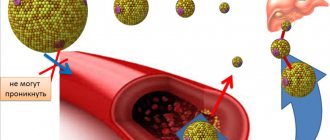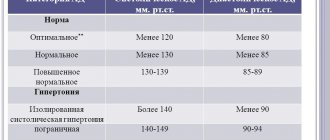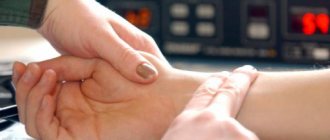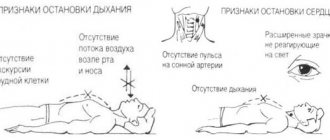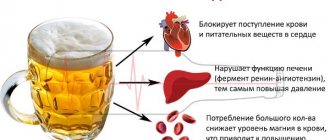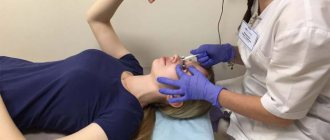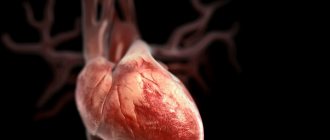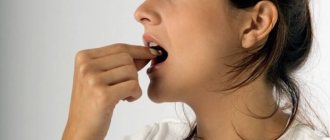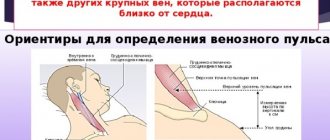Manifestations of the problem
Tachycardia therapy includes 2 goals:
- tactical - to stop an attack;
- strategic – to prevent relapses.
To stop tachycardia, depending on its type, it is allowed to use pharmacological drugs: ATP, Adenosine, calcium channel blockers (Verapamil), beta blockers (Metoprolol), antiarrhythmics (Propafenone, Amiodarone, Novocainamide). You can read more about the medications used for this purpose here.
When paroxysm occurs with unstable hemodynamics (drop in blood pressure) and loss of consciousness, emergency electrical cardioversion may be required.
If the patient has confirmed reciprocal tachycardia (AV nodal, with the participation of additional conduction pathways), then surgery may be proposed in this situation. Performing radiofrequency ablation with destruction of the arrhythmia substrate is productive in 90% of cases.
If surgery is unsuccessful, you will need to take medications to prevent new attacks. In this case, when choosing a drug, you need to balance the benefits and potential risks, since drugs for the treatment of arrhythmia have a proarrhythmogenic effect (they can contribute to the intensification of the pathology or the emergence of a new form of it).
Elimination of provoking factors, such as drinking alcohol, strong tea and coffee, taking certain medications (adrenergic agonists, digitalis), and treating the cause of the disease are necessary components of therapy. Don't forget about stress either. When no organic causes of tachycardia are found, during a conversation with the patient, I often establish a connection between his emotional state and the cardiac signs that have arisen.
There are situations when a convincing and sincere conversation with the patient is not enough, and there is a need to consult a psychotherapist. The modern rhythm of life for many of us can easily be called “stressful”. Stress at work and family problems cause persistent changes in a person’s behavioral mirror. It is they who change the patient's reaction to ordinary life things, which often leads to tachycardia.
It is impossible not to mention homeopathy, since the number of supporters of this trend did not decrease even after the Russian Academy of Sciences recognized it as a pseudoscience. The use of such drugs is based on the placebo effect and “helps” only a patient with astheno-neurotic syndrome without pathology of internal organs. The consequence of using homeopathic remedies in patients with serious rhythm disturbances will be life-threatening arrhythmia. Such a danger can be avoided by prescribing pathogenetic therapy, and not “dummy”.
Symptoms and treatment of tachycardia are a pressing problem in cardiology, which requires a professional approach from specialists with education and experience. In many regions there are centers where arrhythmologists work - doctors who treat electrical disorders of the heart. They have the power to thoroughly understand the reasons and choose the optimal management tactics.
Treatment
How to treat tachycardia in each specific case is determined by a cardiologist. Sometimes he may need to consult other specialists: a neurologist, endocrinologist, therapist, urologist - depending on the reason that caused the increase in the number of heartbeats.
Of great importance is the elimination of factors that cause attacks of rapid heartbeat: smoking, drinking alcohol, drinking coffee and caffeine-containing drinks, heavy physical activity, emotional disturbances and stress. This is usually sufficient to eliminate physiological tachycardia.
Treatment of pathological tachycardia requires additional measures: in addition to eliminating provoking factors, it is imperative to treat the underlying disease.
If the tachycardial syndrome is neurogenic in nature, consultation with a neurologist is required. It is important to prescribe sedatives and sedatives, sometimes tranquilizers or neuroleptics.
If the heart begins to beat faster than necessary, due to the fact that the amount of blood in the circulatory system has decreased (for example, due to severe blood loss), it is necessary to replenish its volume adequately. A decrease in heart rate without this can provoke a drop in blood pressure and only aggravate the symptoms of hemodynamic disorders. For anemia, the administration of iron supplements is important.
What to do in case of tachycardia that has developed against the background of thyroid disease (thyrotoxicosis) is decided by the cardiologist together with the endocrinologist. It is important to treat the underlying disease. However, beta-blockers or calcium antagonists are added to this.
Beta-blockers are also used if tachycardia occurs against the background of chronic heart failure. In addition, cardiac glycosides are prescribed.
If tachycardia is caused by any infectious diseases, antibacterial or antiviral drugs are prescribed.
If ventricular tachycardia occurs, treatment must be started as an emergency, for which the patient is hospitalized in a medical facility.
For some indications, increased heart rate is treated surgically. For this purpose, the radiofrequency ablation method is used. A special catheter-electrode is inserted into the heart cavity through large vessels, with the help of which the pathological focus that produces unnecessary impulses is cauterized.
Main symptoms
Tachycardia manifests itself in different ways; clinical symptoms depend on age and concomitant diseases. Rapid heartbeat may be accompanied by a feeling of discomfort in the chest, a drop in blood pressure, and weakness. There may be a feeling of shortness of breath, dizziness, darkening of the eyes, fainting. A patient with angina pectoris experiences chest pain as a result of an imbalance between the heart's increased oxygen demand and decreased O2 delivery. In people with heart disease, an attack of tachycardia is accompanied by a sharp increase in shortness of breath.
Features of the floors
There are no particular differences between the manifestations of tachycardia in men and women, except for autonomic reactions and emotional overtones.
The heart beats and bubbles in the throat, gives rise to fever, severe sweating, trembling in the body - this is how the signs of tachycardia in women are vividly described. They are more likely than men to have chronic non-paroxysmal sinus tachycardia - a disease when heart rate does not correspond to the level of physical activity or emotional stress. A possible mechanism for its development is considered to be an anomaly of the sinus node or increased automaticity of the heart.
Postural orthostatic tachycardia is also predominantly characteristic of women. It is accompanied by an inadequate increase in heart rate when the body position changes from horizontal to vertical.
Causes
The causes of sinus tachycardia can be divided into two large groups:
- Intracardiac – the reasons for the increase in heart rate lie in the heart itself. They can be either congenital or due to various heart diseases.
- Extracardiac - heart rate increases due to various extracardiac factors: diseases of other organs and systems or under the influence of external factors.
The heart rate can increase with almost any cardiovascular disease, including:
- cardiac ischemia;
- arterial hypertension;
- myocardial infarction;
- heart failure, both acute and chronic;
- heart defects, both congenital and acquired;
- cardiosclerosis;
- cardiomyopathy - this reduces the contractility of the heart, which reduces the amount of blood that it releases into the vessels in one contraction; to compensate for this, he has to work faster; infective endocarditis and others.
Extracardiac causes of tachycardia:
- physiological reasons - heart rate increases during active physical work, due to anxiety, strong emotional stress;
- neurogenic - they occur when the functioning of the cerebral cortex and subcortical nodes is disrupted, and also with various dysfunctions of the autonomic nervous system: neuroses, affective psychoses, neurocirculatory dystonia; most often they affect young people with an unstable nervous system;
- diseases of the endocrine system;
- shock;
- collapse;
- acute blood loss;
- severe pain attack;
- taking medications that affect the functioning of the sinus node (adrenaline, atropine, aminophylline and others); tachycardia, the causes of which lie in taking medications, is called drug-induced;
- Not only medications, but also nicotine, alcohol, coffee and caffeine-containing drinks can increase your heart rate;
- fever in some infectious diseases (pneumonia, tonsillitis, tuberculosis, etc.) - it has been established that raising body temperature by one degree increases heart rate by about 8-9 beats per minute.
In addition, tachycardia can be adequate or inadequate. The latter does not go away even after a person has eliminated any stress, physical or emotional. It is also not possible to find the cause of tachycardia at first glance. By all parameters, the heart should beat evenly and calmly, because there are no provoking factors. Why it occurs is not fully understood, but there is an assumption that it is associated with a primary lesion of the sinus node.
Determining the type of tachycardia is important for prescribing the correct treatment, since most often it is not it that needs to be treated, but the pathologies that caused it. Simply lowering your heart rate without addressing the cause can cause a drop in blood pressure.
Treatment of rapid heartbeat: how to get rid of the problem
If a person's heart beats loudly before going to bed, it is difficult for him to fall asleep. Thus, he is deprived of proper rest. Therefore, it is not surprising that people who have experienced this problem are always looking for a way to get rid of it.
First of all, you need to consult a cardiologist to rule out diseases of this organ. For such complaints, experts recommend doing an ECG or ECHO-CG. Daily monitoring using a Holter device may also be required.
If the examination reveals any problems, the doctor will prescribe treatment depending on the extent of the disease.
Strong heartbeat caused by other reasons can be treated by eliminating them and following a daily routine. Usually, if the patient begins to lead a healthy lifestyle, the problem goes away on its own.
To prevent heart palpitations from occurring and causing trouble, just follow a few simple recommendations:
- Do not eat food shortly before you need to go to bed. You need to have dinner at least 2-3 hours in advance.
- Dinner should be light. You should not indulge in fatty, fried, spicy, etc. It is better if a person feels slightly hungry than to overeat until his stomach becomes heavy.
- You should not engage in active sports or perform heavy physical work at late hours. It is better to plan everything in such a way that such activities occur during the daytime.
- It is necessary to avoid drinking coffee, tea and other invigorating drinks in the evening. Replace them with juices from fresh vegetables and fruits, herbal infusions, kefir or clean water.
- A leisurely walk in the fresh air has a beneficial effect on the body.
- It should be a rule to ventilate the bedroom in the evenings. This is especially important if the problem is caused by a stuffy room.
- For problems caused by anxiety and anxiety, taking mild sedatives will help. These could be: Zelenin drops, valerian, mint tea.
About tachycardia
What is sinus tachycardia? In a broad sense, the term “tachycardia” is commonly understood as heartbeat at an increased rate. The rate of contraction of the ventricles of women varies from 60 to 80 beats per minute.
The heart rate can reach 140 to 180 beats/minute if the sinoatrial node malfunctions and generates impulses more often.
Sinus tachycardia of the heart, in addition to rapid heart rate, is manifested in the following symptoms:
- dyspnea;
- lethargy, weakness of the body;
- dizziness;
- pain, pressure in the chest.
Rapid heartbeat is not a disease, it is a symptom . It is possible to characterize both a special physiological state at a certain point in time, and one of many diseases.
Clinical case
In my practice, there was a case of sinus tachycardia in a pregnant woman. The woman constantly felt a rapid heartbeat, which was an adaptive reaction of the body: pressure decreased, heart rate increased; but the patient was also diagnosed with anemia. After correcting the hemoglobin level with iron supplements, her health improved and the feeling of palpitations disappeared. Although at first the woman was sincerely surprised when she was not prescribed drugs to slow down her pulse!
Depending on the location of the source of excitation, tachycardias are divided into supraventricular and ventricular.
The first arise in the structures of the heart up to the level of branching of the trunk of the His bundle: in the atria, AV node, in additional conduction pathways. The source of origin of the latter is the His bundle, Purkinje fibers, and ventricular myocardium.
Based on the nature of the course, paroxysmal and non-paroxysmal types of pathology are distinguished.
According to the mechanism of occurrence - reciprocal, ectopic, with trigger activity, and so on.
Differential diagnosis of arrhythmias is a difficult and responsible task. In particular, when it comes to tachycardia with wide QRS complexes on the ECG. This may be a ventricular arrhythmia or tachycardia involving the accessory tract (accessory tract).
Ventricular tachycardia has a poor prognosis and occurs as a result of damage to the heart muscle. In contrast, arrhythmia involving the AP appears in a person without gross structural pathology of the heart.
To clarify the type of tachycardia, an ECG with an intrathoracic lead should be recorded or a transesophageal electrophysiological study should be performed. However, in real clinical practice, such an opportunity is rarely provided, and in these situations the doctor is guided by the following rule: assess the condition as the most dangerous to human health and life and begin appropriate treatment.
Consequences
How dangerous the consequences of heart palpitations in the evening can be depends on the cause. Heart disease can lead to serious complications if treatment is not started promptly.
But even harmless reasons create a lot of inconvenience. This is lack of air, shortness of breath, inability to sleep. And regular lack of sleep leads to fatigue, irritability, and decreased performance.
Therefore, it is important to determine the cause of this phenomenon in time, lead a healthy lifestyle and avoid anything that can cause palpitations before bedtime.
Diagnostics: when and with what to see a doctor?
With the complaint “when I go to bed, my heart beats strongly” you need to contact a cardiologist directly. This is a doctor whose specialization is diseases of the cardiovascular system.
If a patient complains of increased heartbeat, the doctor will first determine the reasons - whether it is of physiological or pathological origin. For this purpose, laboratory and instrumental studies may be prescribed, including ECG, echocardiography (ultrasound of the heart), and radiography of the heart. If the cardiologist diagnoses pathological changes in the heart, appropriate treatment will be prescribed. If no pathologies are found, and the arrhythmia continues to haunt the patient in the evenings, you should contact a neurologist.
A neurologist or neuropathologist will prescribe sedatives and sedatives. In the absence of pathologies of the cardiovascular system, most often the cause lies precisely in nervous disorders. A course of well-chosen tranquilizers in the required dosage will help completely relieve symptoms of anxiety, which most often take the form of insomnia, tachycardia and arrhythmia.
Any first-time attack of tachycardia that negatively affects your well-being is a reason to consult a doctor! And the more pronounced the clinical manifestations, the sooner you need to consult. If a person loses consciousness during a paroxysm, it is necessary to immediately call an ambulance and perform electrical cardioversion (impact of a pulsed current discharge on the heart).
Doctor's advice: check-up list for suspected tachycardia
To establish a correct diagnosis, the following studies and tests are necessary:
- electrocardiogram - at rest and at the time of rapid heartbeat;
- Ultrasound of the heart - data on the structural structure and valve apparatus;
- daily ECG monitoring;
- transesophageal EPI (TEPE);
- general blood test - will provide information about the presence of anemia and/or inflammation;
- blood test for thyroid hormones and TSH;
- consultation with an ENT doctor (if you have a history of frequent sore throats) and a dentist (caries) to identify and treat foci of chronic infection.
This is the minimum research that will help establish the cause of tachycardia, its nature and type, or allow you to choose a further diagnostic direction. Often, the doctor needs to seek help from fellow arrhythmologists who are able, using modern instrumental methods, to determine the area with pathological impulses. After its localization becomes known, the issue of minimally invasive destruction of the lesion can be decided.
If rapid heartbeat is the result of chronic tonsillitis, then by eliminating the cause (by performing surgical removal of the tonsils), you can forget about the heart problem. Such patients complain of pain in the heart area. Why chest discomfort occurs with a sore throat and how to act correctly - read here.
If the study reveals changes in thyroid hormone levels, or pheochromocytoma is suspected, then an endocrinologist will treat such a patient. It is worth noting that in clinical practice the first symptom of thyrotoxicosis is paroxysm of atrial fibrillation. Therefore, all patients with new-onset atrial fibrillation need to determine the concentration of thyroid hormones in the blood.
Monitoring a person with tachycardia first of all involves monitoring by a specialist who treats the underlying disease. It is a competent approach to the pathology that causes arrhythmia that will help get rid of unpleasant symptoms and minimize the consumption of medications.
Diagnostics
The following methods are used in diagnosis:
- ECG. It may not be informative in case of paroxysmal arrhythmia, which bothers the patient only at night and not during the daytime.
- ECG Holter monitoring - electrodes are fixed to the human body and an ECG is recorded all day long, even during sleep. After recording, the data is output to a computer and decrypted by specialists.
- Transesophageal electrophysiological study. This is a study of the conduction system of the heart using electrodes that are inserted through the esophagus.
- EchoCG is a method that allows you to visualize the chambers of the heart, valves, great vessels, and the condition of the heart muscle.
Also, to find out the causes of tachycardia, the following are used: ultrasound of the thyroid gland, general, biochemical blood tests, MHO analysis, determination of blood glucose levels.
Methods to normalize the heartbeat without the help of medications
Most patients determine increased heart rate by the following signs:
- the heart beats loudly and seems to be trying to jump out of the chest;
- noise and response of the heartbeat in the temples and back of the head;
- darkening of the eyes, a feeling of imminent loss of consciousness;
- twitching of the little finger on the left hand;
- a pinching sensation in the area where the heart is located.
With a normal heart rate, such sensations never occur. This pathology signals chronic diseases of the cardiovascular system, which are most often psychosomatic in nature (i.e. associated with anxiety, excitement, fear).
Increasing arrhythmia frightens many patients (especially the elderly). They begin to panic, gasp for air, choke, and make unnecessary body movements. This behavior contributes to an even greater increase in the number of heartbeats per minute.
There is a set of simple tips and rules approved by official medicine (some of them are borrowed from hatha yoga) to normalize heart rate:
- try to take a comfortable position so that there are no creases in the body, and the spine is straight and relaxed;
- monitor your breathing: take deep breaths and exhales, trying to contract the diaphragm;
- concentrate on the point on the bridge of your nose and close your right nostril with your thumb, take a slow, deep breath in and out. Then close your left nostril with your index finger and take a few more deep breaths in and out through the right.
- in some cases, relief comes from gargling with cool water or applying a damp, cold towel to the chest and neck area;
- You should drink a glass of cool water, take a sedative tablet (in no case should you take alcohol tinctures such as Corvalol or Valoserdina) or a heart medication.
If after all these manipulations the strong heartbeat does not subside when falling asleep, you need to call an ambulance. In some cases, tachycardia can provoke many complications, which can lead to death.
About sinus tachycardia and its types
Sinus tachycardia is a type of arrhythmia characterized by increased activity of the sinus node. The sinoarterial node is the main source that generates electrical impulses that set the normal heart rhythm. With sinus tachycardia, the number of heart contractions exceeds 100 beats per minute.
The characteristic symptoms of this disease cannot be ignored.
During an attack, a person is worried about:
- • Rapid heartbeat, feeling as if there is a lump in the throat.
- • Severe weakness, aching pain in the temples or the back of the head, severe dizziness.
- • Shortness of breath even in the absence of physical activity.
- • Constrictive pain in the left side of the chest. The pain can radiate to the arm, shoulder, or scapula area.
- • Panic, fear for your life.
- • Cold sweat.
- • Decreased performance.
- • Poor tolerance of even minor physical activity.
In medicine, the following types of sinus tachycardia are distinguished:
- • Physiological . This type of heart rhythm disorder can occur in people who do not have any health problems. Physiological tachycardia is often diagnosed in young children under 7 years of age, adolescents during puberty, and people whose lives often involve increased physical activity.
- • Pathological . It is a consequence of the progression of diseases of the cardiovascular system in the body, as well as pathologies of other internal organs. Pathological sinus tachycardia is a dangerous disorder that requires timely detection and treatment. Otherwise, life-threatening complications cannot be avoided.
Sleeping pills without addiction and dependence without a prescription
According to the nature of the course, the following subtypes of sinus tachycardia are distinguished:
- • adequate;
- • inadequate.
Inappropriate tachycardia is a rare, little-studied pathology. Heart rhythm disturbances during an attack do not depend on the load, the use of provoking medications, and can persist in a state of absolute rest.
The main symptoms of tachycardia of this type:
- • Strong heartbeat – up to 220 beats per minute.
- • Acute lack of air.
- • Blurred consciousness.
How to relieve an attack of tachycardia: first aid
Enter your pressure
Move the sliders
- suffered severe stressful situations;
- problems with the heart and blood vessels;
- obesity;
- pathologies of the endocrine system;
- problems with the thyroid gland;
- gastrointestinal deviations;
- malfunction of the central nervous system;
- presence of asthma;
- rheumatism;
- hypoxia;
- pneumothorax;
- pulmonary obstruction;
- thyrotoxicosis;
- allergies.
When a rapid heart rate occurs during sleep or rest, it may indicate heart problems.
Nocturnal tachycardia provokes poor sleep, the patient is overtaken by unreasonable anxiety, the heart rate increases to such an extent that the patient begins to feel pulsation. It happens that headache and weakness occur, and chest pain is possible. If tachycardia occurs after sleep, when you get up, the patient may experience semi-fainting and frequent darkening of the eyes.
A rapid heartbeat in the morning is more noticeable, since the body, emerging from a state of sleep, works in a more exhausted mode. The patient feels trembling throughout the body, and severe weakness may occur when standing up. Tachycardia in the morning and evening may be accompanied by profuse sweating (cold and sticky sweat) and a state of suffocation. Frequent pulsation of blood vessels and palpitations that occur in the morning after waking up or in the evening when falling asleep cannot be ignored.
Vagal tests can be used as an emergency aid. Their meaning is to irritate the receptors of the parasympathetic nervous system, as a result of which the vagus nerve is activated. Performing these techniques will help either interrupt the paroxysm or lower the heart rate and reduce symptoms.
- Valsalva maneuver. While sitting or standing, take a deep breath, then pinch your nose, close your mouth and try to exhale, while straining the anterior abdominal wall.
- The cough reflex is simple to perform: the patient needs to cough.
- The gag reflex is to press on the root of the tongue.
- Squatting with straining.
- Diving dog reflex: hold your breath, pinch your nose and lower your face into a container of cold water.
- Carotid sinus massage. Prohibited for patients with atherosclerotic lesions of the carotid arteries and/or a history of stroke. It is carried out as follows: the pulsation point on the neck is determined and several pressures are applied on it for 3-5 seconds.
- Danini-Aschner test - pressure on the eyeballs; currently not recommended for use.
In addition to vagal tests, medications are used for emergency care. Verapamil is widely used, but its use is possible only when it is reliably known that there are no additional pathways in the myocardium. If atrial fibrillation has developed, then Propafenone, the “pill in your pocket” technique, can help. This drug is taken only if it has been previously successfully used in a hospital under the control of an electrocardiogram.
In my practice, during transesophageal pacing, patients often developed an attack of reciprocal AV nodal tachycardia. The use of vagal maneuvers (Valsalva and carotid sinus massage) made it possible to stop paroxysm. The entire process is demonstrated on the screen of the ECG installation: against the background of a smooth sinus rhythm, an attack of tachycardia with narrow QRS complexes suddenly occurs.
If wide complex tachycardia develops during TEE, you can try to stop it using several electrical stimuli. The cessation of paroxysm in this way indicates the supraventricular nature of the arrhythmia. If the source is located in the ventricles of the heart, then stimulation will not affect the course of the attack in any way.
When to call an ambulance
According to clinical recommendations, you need to call the emergency room if an elevated pulse persists for 20 minutes or more. 90-120 - acceptable indicators. The remaining options are already dangerous.
In addition to changes in heart rate, other symptoms may be present:
- Panic attack. The patient feels intense fear, rushes about, cannot find a place for himself. The reverse process is possible. The patient completely loses interest in the world and is indifferent to external stimuli. Both are bad.
- Pressing pain in the chest. They indicate an ischemic process, which in itself is extremely dangerous. Perhaps we are talking about an attack of angina or a heart attack.
- Fibrillation, extrasystole. Subjectively, it feels like missing beats in the chest, slowing down activity, tying a knot.
- Dyspnea. Against a background of complete peace. The patient cannot not only engage in physical activity, but also simply lie down.
- Headache, dizziness, neurological signs. They develop as a result of insufficient blood circulation in cerebral structures.
- Weakness, drowsiness, general malaise.
The patient feels an increased pulse even at night, which prevents him from sleeping normally. A decrease in blood pressure is objectively detected.
For what reasons does a rapid heartbeat develop?
Factors that contribute to the appearance of arrhythmia and tachycardia:
- physical activity (jogging, anaerobic exercise, climbing stairs);
- taking certain drugs that cause heart palpitations;
- surges in blood pressure for one reason or another;
- mental problems, neuroticism, fear, anxiety, excitement;
- increased consumption of caffeine (it is found not only in coffee drinks, but also in Coca-Cola, Fanta);
- conditions and diseases in which the diaphragm rises upward.
These are all standard causes of palpitations. Before bedtime, they may differ in specificity. Not all patients with diseases of the cardiovascular system may experience problems at certain times of the day - this condition says a lot.
Etiology
Tachycardia can manifest itself at any age; each period of life is dangerous with its own factors. Doctors distinguish between the physiological and pathological types of the disease; the treatment and prognosis of the disease depend on this classification. The doctor will tell you during a face-to-face consultation what to do if you have palpitations, and how to learn to cope with such attacks on your own.
Physiological tachycardia is a high rhythm of myocardial contractions, which is provoked by external factors. What some people don't know is that regular daily activities make your heart beat faster. In this case, an attack occurs due to such an irritating moment, and ends after it is eliminated, or the body independently copes with such a load.
Causes of physiological tachycardia:
- Excitement and emotional experiences.
- Severe stress, fear.
- Intense sports activities.
- Spending a long time in a hot and stuffy room when there is a lack of air.
- Sexual arousal.
- Binge eating.
It is noteworthy that physiologically, a rapid heartbeat is not dangerous for a person; there is no need to think about how to calm the functioning of the organ - everything returns to normal without the help of drugs.
The pathological type of tachycardia is a more dangerous condition. Doctors identify several main diseases that affect the appearance of disturbing symptoms.
Cardiovascular system
If the causes of rapid heartbeat lie in the pathology of the entire system, then tachycardia is considered serious. The increased work of the department, in this case, is caused by the increased load on this area. It is important to diagnose the disease in time so that the person’s condition does not become fatal.
- Often, an increase in heart rate is observed accompanied by hypertension, since the pressure on the walls of blood vessels becomes excessive, the organ will definitely react to this process. If the arteries are severely damaged by atherosclerotic plaques, then their flexibility is impaired, and a rapid pulse can lead to the development of a stroke or heart attack.
- The pulse is a fluctuation of blood in the vascular bed, which is caused by the process of contraction of the atria and ventricles. When the functioning of the organ is normal, blood is ejected from the area of the ventricles and atria, passing into the arteries. If the heartbeat is too active, then the entire rhythm of such blood pumping is disrupted, it stagnates in the organ, which increases the risk of thrombosis. Bradycardia can also occur against the background of this pathological process.
In this case, a person may experience a lot of unpleasant sensations, which signal the need to visit a doctor.
Autonomic disorders
What to do if your heart beats frequently and how to help yourself - such questions are often asked in the office of a cardiologist and therapist, especially in the hot season. A low or high heart rate, as well as other abnormalities in the functioning of the organ, can be caused by a malfunction of the autonomic system. It can be difficult to stop such a pathological process on your own, since the person does not understand what has changed his condition, panics, his breathing becomes difficult, and the situation worsens.
Medicine classifies the autonomic system into two parts, sympathetic and parasympathetic. The first department is responsible for the activity of the body, and the second is for relaxation. Due to this, the activity of all organs can change; the contraction of the heart also increases or decreases the pace of work.
When a person is diagnosed with VSD (vegetative-vascular dystonia), it often provokes tachycardia. The number of heart beats is calculated by the doctor. A minute is the unit of time in which each organ beat is counted. The norm for such numbers should vary between 60-90 contractions. A slow or accelerated pace of work is often provoked by the vegetative department, but few people realize this. Despite the deterioration in health, tachycardia caused by this influence is not considered dangerous.
Endocrine system
Increased synthesis of certain hormones can cause increased heart rate, and only the doctor decides what to do in this situation after studying the patient’s test results. It is impossible to regulate the production of some enzymes on your own. Hyperthyroidism is one of the diseases in which a similar pathological process occurs. When the secretion of thyroid-stimulating hormone by the thyroid gland is excessive, a person’s condition deteriorates sharply. It is possible to slow down the functioning of the organ only by stabilizing the level of these substances in the blood.
A strong pulse is dangerous when it is periodic, and if the patient is diagnosed with concomitant pathologies of the cardiovascular system, then the health and functioning of all organs worsens.
When I go to bed - strong heartbeat: reasons
Most often, this pathology is psychosomatic in nature. The appearance of tachycardia and arrhythmia at night or in the evening more than once a month should alert the patient and encourage him to consult a cardiologist, who, in turn, will most likely refer him for examination to a neurologist.
True tachycardia and arrhythmia develop arbitrarily, at any time of the day. If a patient complains that the heart is beating strongly before going to bed (or at any other stable time of day), then you need to look for the roots of the problem in psychosomatics.
Prevention
As with any disease, an important place should be given to prevention, because any disease is easier to prevent than to treat. Tachycardia is not gender specific and can occur in both men and women, so preventive measures will be beneficial to everyone.
- First of all, it is necessary to normalize the daily routine, go to bed on time and devote a sufficient amount of time to sleep.
- Giving up bad habits is also an important component in preventing an increase in heart rate.
- Stick to proper nutrition: reduce the amount of coffee and chocolate you drink, be sure to include fruits and vegetables in your diet.
- If possible, avoid stress and prolonged nervous tension.
- Despite the fact that physical activity itself can increase the number of heart contractions, it should still be given to the body, but at the same time monitor your condition and control your pulse.
- It is imperative to promptly and correctly treat infectious diseases, undergo medical examination and monitor your health.
Regardless of the cause, it is important to be aware of the symptoms of tachycardia, what it is, how to treat it, and what dangers it can pose.
Taking antiarrhythmic drugs
Since rapid heartbeat before bedtime is most often provoked by psychosomatic causes, specialists often prescribe tranquilizers and sedatives as auxiliary or primary therapy:
- "Atarax" belongs to the group of new generation tranquilizers. Promotes quick fall asleep and sound sleep. Reduces anxiety, excitement, hyperactivity.
- "Adaptol" is ideal for patients whose problems with heartbeat are provoked by a difficult life situation and constant anxiety. This is an excellent sedative, the effect of which begins already on the third or fourth day of use. The patient stops worrying about trifles and quickly falls asleep.
- "Fitosedan" is a completely natural product based on plant components. It has a sedative, sedative and hypnotic effect. has virtually no side effects. In rare cases, may cause allergic reactions.
These medications are aimed primarily at bringing the heart rate back to normal. If a patient comes to a cardiologist with the complaint “when I go to bed, my heart beats strongly,” then with a high degree of probability he will be given a prescription for antiarrhythmic drugs.
The following medications stop an attack of arrhythmia:
- potassium channel blockers (amiodarone);
- sodium channel blockers (procainamide);
- propafenol (class IC antiarrhythmic);
- and calcium channel blockers (verapamil).
These drugs have many side effects, some of which can lead to the development of toxic hepatitis. Therefore, the dosage should be increased gradually, starting from the minimum. The total duration of treatment should be prescribed by a cardiologist based on the patient’s individual medical history.
Why can't you take Corvalol?
A common mistake many patients make is to take a few drops of Corvalol alcohol tincture if their heart beats strongly when falling asleep. Doctors have an extremely negative attitude towards this method of overcoming heart palpitations.
Firstly, Corvalol contains the strongest old-generation tranquilizer, phenobarbital, which causes drug dependence. The habit of old women to treat ari is not only useless, but also harmful.
Secondly, taking even small doses of ethanol has a depressant effect on the central nervous system. This not only does not reduce the heart rate, but in some cases it can provoke a mini-stroke.
Thirdly, Corvalol is an obsolete drug that should not be taken by any patient.
Preventive methods
If you are worried about a strong heartbeat before going to bed, you should consult a doctor and start taking medication.
What to do if the patient does not experience much discomfort and feels a very slight arrhythmia in the evening? Here are simple but effective ways to avoid it:
- an evening walk in a quiet, peaceful place (park, forest belt, field, botanical garden), during which you need to wander in silence and breathe fresh air;
- give up coffee and black tea;
- perform simple breathing exercises alternately with the right and left nostrils (it was described just above);
- do not do any physical exercise five to six hours before bedtime, do not run or jump under any circumstances, do not even walk quickly - all this provokes heart rhythm disturbances;
- exclude from your social circle people whose communication causes anxiety, excitement and other neurotic problems;
- try not to eat fatty meat foods four hours before bedtime: dinner should be as light as possible so that the gastrointestinal tract rests at night.
